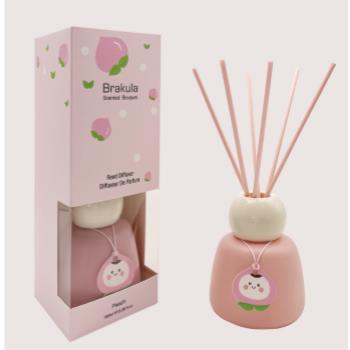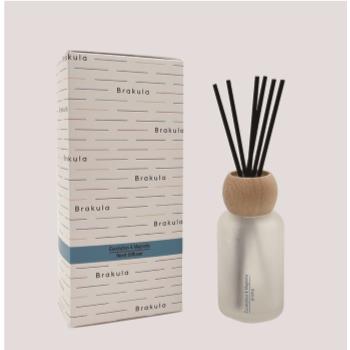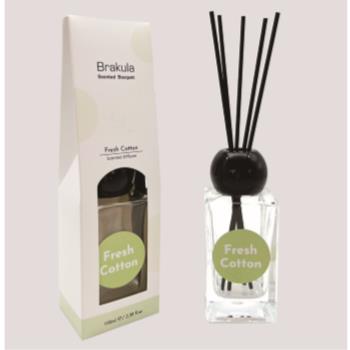How to Use Essential Oil Diffuser Sticks: A Complete Guide
The benefits of reed diffusers go beyond just fragrance; they can improve focus and reduce stress. Whether at home or in the office, reed diffusers with fragrance oil create an inviting atmosphere. Discover how to incorporate reed diffusers into this aromatic experience in your daily routine and enjoy the many perks it brings.

Understanding Essential Oil Diffuser Sticks
Components
Essential oil diffusers consist of three main components: reeds, an oil container, and fragrance. The reeds are thin sticks that absorb the essential oils for diffusers. They are usually made from rattan or bamboo. These materials are porous, allowing them to soak up the oil easily, like reed diffusers.
The oil container holds the reed diffuser oils. It is often made of glass or ceramic. This container keeps the oils secure while allowing easy access for the reeds to use. The fragrance itself comes from essential oils. These oils provide various scents and therapeutic benefits.
Wicking Process
The wicking process in a reed diffuser is crucial for dispersing scent into the air. When you use the reeds in the oil, they soak up the liquid through capillary action. This means that the oil uses upward travel through the reeds. Eventually, the reed diffuser reaches the top and releases fragrance into the room.
This reed diffuser process ensures a steady release of scent over time. As the oils evaporate in the reed diffuser, more oil moves up from the container. This cycle continues until the oil is depleted.
Materials Used for Reeds
Reeds are typically made from natural materials like rattan, bamboo, or synthetic fibers for use. Natural reeds are preferred because they absorb oils better than synthetic options. Rattan, often used in reed diffusers, is especially popular due to its durability and effectiveness in wicking.
The choice of material in a reed diffuser affects how well the fragrance is released. For example, thicker reeds may use hold more oil but can release it slower. Thinner reeds may use disperse scent quickly but might need replacement sooner.
Using quality reeds ensures you use a consistent aroma in your space. Proper maintenance also helps extend their lifespan and effectiveness.
Benefits of Using Essential Oil Diffuser Sticks
Essential oil diffuser sticks offer several advantages:
They provide a continuous scent without flames.
They require little maintenance compared to candles.
They can enhance mood and create a calming atmosphere.
They help eliminate odors naturally.
Choosing the right essential oils for your reed diffuser can influence your experience significantly. Different oils, such as those used in a reed diffuser, have unique properties that can uplift, relax, or energize you.
Step-by-Step Guide to Using Diffuser Sticks
Initial Setup
Begin by gathering your materials. You will need a reed diffuser, essential oils, and the reed sticks. Most diffusers come with a seal on the bottle. Remove this seal carefully to avoid spills.
Next, insert the reed sticks into the bottle. The number of reeds can vary based on the reed diffuser size recommendations. For smaller spaces, 3-5 reeds work well. Larger rooms may require more reed sticks for effective scent distribution.
Flipping Reeds
Flipping the reeds is crucial for scent strength. After inserting them, use a reed and wait about an hour before flipping them for the first time. This allows the oil to use soak into the reeds fully.
Every week, flip the reeds again. This action helps to refresh the scent, use a reed, and ensures even distribution throughout your space. Remember that the more you use the reed to flip, the stronger the scent will be.
Safety Precautions
Safety is important when using diffuser sticks. Keep your reed diffuser out of reach of children and pets. Essential oils can be harmful if ingested or applied directly to skin, so use a reed.
Place the reed diffuser in a stable area where it won't be knocked over easily. Avoid areas with high temperatures or direct sunlight as this can affect oil quality; use reed.
Maintenance Tips
Regular maintenance keeps your diffuser working well. Change out the reeds every few months. Old reeds can use become clogged and stop absorbing oil effectively.
If you notice a decrease in scent strength, use check for oil levels in the bottle. Refill as needed to maintain fragrance intensity.
Choosing Oils
Selecting the right essential oils enhances your experience. Popular options include lavender for relaxation and use citrus for energy. Experiment with different scents to use what works best for you.
Combining oils can also create unique fragrances. However, use small amounts to see how they blend together.
Best Placement for Effective Diffusion
Room Size
Choosing the right spot for your diffuser is key. Larger rooms need diffusers placed in central locations. This helps the scent to spread evenly. In smaller spaces, a corner can work well. It allows the fragrance to fill the area without overwhelming it.
Airflow Considerations
Airflow affects how well the diffuser works. Placing it near an open window or fan can disperse the scent quickly. However, too much airflow can cause the fragrance to fade faster. Aim for a balance. A location with gentle airflow ensures a steady release of aroma.
High-Traffic Areas
Avoid placing the diffuser in high-traffic areas. These spots include hallways or busy living rooms. Constant movement can disturb the oil and reduce its effectiveness. Keeping it in a quieter area helps maintain fragrance longevity. For example, a bedroom or office corner is ideal.
Direct Sunlight
Direct sunlight can degrade essential oils over time. It’s best to keep your diffuser out of direct light. Sunlight heats the oil, causing it to evaporate faster. This change can alter the scent profile as well. Place it on a shelf or table where it stays cool and shaded.
Height Matters
The height of your diffuser also plays a role. Placing it at eye level allows you to enjoy the scent better. If it's too low, you may not notice the fragrance as much. Conversely, placing it too high can lead to uneven diffusion.
Multiple Diffusers
Using more than one diffuser can enhance scent distribution. Different rooms may require different scents based on their use. For instance, calming scents like lavender work well in bedrooms, while citrus scents brighten up kitchens or living areas.
Maintenance Tips
Regular maintenance extends the life of your diffuser and oils. Clean the reeds every few weeks to remove dust and residue. This keeps the scent fresh and strong. Also, replace oils when they become weak or lose their fragrance.
Choosing the Right Number of Reeds
Many Reeds
The number of reeds you use can greatly influence the scent intensity and overall coverage in your space. More reeds mean a stronger scent, while fewer reeds will result in a milder aroma. If you want a subtle fragrance, consider using only a few reeds. However, for a more pronounced scent, many reeds will do the trick.
Adjusting the number of reeds is essential based on your personal preference. Some people enjoy a strong scent that fills the room. Others prefer a lighter touch. Experimenting with different reed counts helps you find the best fit for your needs.
Additional Reed Sticks
Adding additional reed sticks can enhance the fragrance experience. If you notice that the scent has faded, inserting new reeds can refresh it. This method works well if you want to maintain a consistent aroma without replacing the entire diffuser.
etimes, using premium quality rattan reeds makes a difference too. These reeds are designed to absorb and release oils more effectively. They help distribute the scent evenly throughout your space.
Rattan and Bamboo Reeds
Rattan reeds are popular because they are durable and effective. They have tiny holes that allow for better oil absorption. Bamboo reeds also work well but may not last as long as rattan. Choose according to your preference and desired longevity of use.
Consider the size of your room when deciding on the number of reeds. A larger room may require more reeds to achieve an even scent distribution. Smaller spaces might only need a few sticks to fill the area with fragrance.
New Reeds
When switching out old reeds for new ones, it's important to clean the diffuser bottle first. Residual oils can affect the new scent's quality. After putting in fresh reeds, allow some time for them to soak up the oil before judging their effectiveness.
Finding the right number of reeds takes some trial and error. Start with a standard amount, like five or six, then adjust based on how strong or mild you want the scent to be.
Optimal Balance
Ultimately, finding an optimal balance is key. Consider these steps:
Start with five or six reeds.
Evaluate the scent strength after 24 hours.
Adjust by adding or removing reeds as necessary.
Test different types of reeds for varied experiences.
Keep track of which combinations work best for your space.
Flipping Reeds for Optimal Scent Release
Frequency Recommendations
Flipping natural reeds is essential for optimal scent release. Experts recommend flipping them every week. This frequency helps maintain a strong fragrance in your space. The process of flipping allows the reeds to absorb more oil. Fresh oil exposure rejuvenates the scent, making it more vibrant.
Rejuvenating Oil Absorption
Flipping the slender reeds enhances the oil absorption process. When you flip them, the ends that were previously submerged now face upward. This change allows those ends to soak up more essential oil. The result is a more consistent scent distribution throughout the room.
Over time, reeds can become saturated and less effective. Regularly flipping them ensures they do not lose their ability to diffuse fragrance. If you notice a decrease in scent strength, it might be time to flip again.
Environmental Factors
Humidity plays a significant role in scent release. In areas with high humidity, oils may evaporate faster. This evaporation can affect how well the reeds perform. In drier environments, reeds may absorb oil more slowly.
Temperature also influences how scents disperse in the air. Warmer temperatures can enhance the diffusion process, while cooler ones may slow it down. Understanding these factors can help you adjust your reed flipping schedule accordingly.
Key Takeaways
Flip natural reeds weekly for best results.
Flipping rejuvenates oil absorption.
Humidity and temperature impact scent release.
Frequency of Replacing Diffuser Reeds
Replacement Timing
Diffuser reeds need regular replacement. It is best to change them every 1-2 months. This timeframe helps maintain the scent quality and effectiveness of your reed diffuser. If you notice that the fragrance has weakened, it may be time for new reeds.
Changing the reeds coincides with oil changes. When you refill the reed diffuser, consider using fresh reeds as well. Old reeds can become saturated and lose their ability to absorb the oil properly.
Drawbacks of Old Reeds
Reusing old reeds can lead to problems. They may retain old scents, which can mix with the new oil and create an unpleasant smell. This can affect the overall experience of using a reed diffuser.
Old reeds also tend to clog over time. Dust and debris can build up in the tiny channels of the reeds. This clogs the flow of oil and reduces scent release. A clogged reed cannot effectively diffuse fragrance into the air.
Maintenance Checks
Regular checks are essential for maintaining fragrance quality. Inspect your diffuser reeds often for dust or any signs of clogging. Cleaning them can help prolong their life and effectiveness.
Use a soft cloth to wipe away any dust on the surface of the reeds. Also, ensure that the base of the reeds is submerged in essential oils. If they are not, this could indicate that they need replacing.
Choosing Reed Size
The size of your diffuser reeds matters too. Longer reeds absorb more oil and release fragrance more quickly. A rattan reed diffuser typically comes in various sizes, so select one based on your space and scent needs.
A larger room may require longer or more numerous reeds to fill the space with fragrance effectively. Conversely, a smaller area might benefit from fewer or shorter reeds to avoid overwhelming scents.
Enhancing the Strength of Your Diffuser Scent
Cleaning Vessel
Cleaning your diffuser vessel is essential. Dust and residue can block the scent. Regular cleaning improves the reed diffuser smell strength. Use warm, soapy water to wash the container. Rinse it well and let it dry completely before adding new scented diffuser oil.
Replace the oil every few weeks. Old oil can lose its potency. Fresh oil provides a stronger aroma. Consider using a reed diffuser tray to catch any spills. This keeps your area clean while enhancing the experience.
Adjusting Reed Quantity
The number of reeds in your diffuser matters. More reeds mean a stronger scent. Start with five to seven reeds for a small room. For larger spaces, use up to ten reeds.
Positioning also affects fragrance strength. Place the reed diffusers in high-traffic areas for better airflow. Avoid placing them near vents or drafts, as this can disperse the scent too quickly.
High-Quality Oils
Using high-quality essential oils is crucial for a potent aroma. Look for fragrance oil that is pure and natural. Synthetic oils may not provide the same depth of scent.
When selecting diffuser oils, consider citrus options like lemon or orange for fresh scents. Floral oils like lavender offer calming effects. Experiment with different combinations to find what you enjoy most.
Replacing Oil Regularly
Regularly replacing the reed diffuser oil ensures a consistent fragrance experience. As mentioned earlier, old oil can diminish the scent strength over time. Aim to refresh your oil every two to four weeks, depending on usage.
Monitor how quickly your oil evaporates. If it seems to run out faster than expected, consider using fewer reeds or switching to a thicker oil.
Proper Placement
Placement of your reed diffuser affects its performance significantly. Avoid direct sunlight or heat sources that can cause rapid evaporation of the oils. Instead, choose a cool, dry location for best results.
Place the diffuser at eye level if possible. This allows you to enjoy the scent more effectively and enhances the overall aesthetic of your space.
Maintaining and Caring for Diffuser Sticks
Simple Care Tips
Caring for your diffuser sticks is essential. Regular maintenance ensures they last longer and perform better. Flipping the sticks every week helps distribute the scent evenly. This simple action prevents one end from becoming saturated while the other remains dry.
Cleaning the diffuser is also important. Dust can build up on the sticks over time. Wipe them gently with a soft cloth to keep them clean. Avoid harsh chemicals, as they can damage the materials. Keeping your diffuser area tidy enhances the overall experience.
Changing Reeds and Oil
Changing the reeds and oil is crucial for consistent scent performance. Replace the reeds every month or when you notice a decline in fragrance strength. Fresh reeds absorb oil better and release scent more effectively.
Switching out the oil is equally vital. Essential oils lose their potency over time. If you notice a weaker scent, it may be time to change the oil. Choose high-quality oils for the best results. The right combination of reeds and oil keeps your home smelling pleasant.
Proper Storage
Storing diffusers correctly prolongs their lifespan. When not in use, keep them in a cool, dark place. Sunlight and heat can degrade both the reeds and oil. Always store them upright to prevent leaks or spills.
If you plan to switch scents frequently, consider having multiple sets of reeds on hand. This practice allows for quick changes without waiting for old reeds to dry out completely.
Final Remarks
Using essential oil diffuser sticks can transform your space into a fragrant haven. You’ve learned how to choose the right reeds, place them effectively, and maintain their scent. Proper care ensures that your diffuser sticks last longer and provide a consistent aroma, enhancing your environment.
Now it’s time to put this knowledge into action. Experiment with different oils and placements to find what works best for you. Share your experiences and tips with friends. Let the soothing scents elevate your mood and create a welcoming atmosphere in your home. Happy diffusing!
Frequently Asked Questions
How do essential oil diffuser sticks work?
Essential oil diffuser sticks absorb the fragrance oil through their porous reeds. As the oil travels up, it diffuses into the air, releasing a pleasant scent that enhances your space.
How often should I flip my diffuser reeds?
Flipping your diffuser reeds every 1-2 weeks is recommended. This helps to refresh the scent and ensures even diffusion of the essential oils.
Can I use any essential oil in my diffuser sticks?
Not all oils are suitable for diffuser sticks. Use high-quality, pure essential oils specifically designed for reed diffusers for optimal results and safety.
How long do diffuser sticks last?
Typically, diffuser sticks last about 1-3 months, depending on the size of the bottle and the number of reeds used. Factors like room temperature and airflow can also affect longevity.
What’s the best place to put my diffuser sticks?
Place your diffuser sticks in a well-ventilated area but away from direct sunlight or heat sources. This ensures maximum scent distribution and prolongs the life of the oils.
How do I enhance the strength of my diffuser scent?
To enhance your diffuser scent, consider adding more reeds or using a higher concentration of essential oil. You can also try combining different oils for a unique fragrance blend.
When should I replace my diffuser reeds?
Replace your diffuser reeds every 1-2 months or when you notice a decline in scent strength. Fresh reeds improve absorption and ensure consistent fragrance release.



